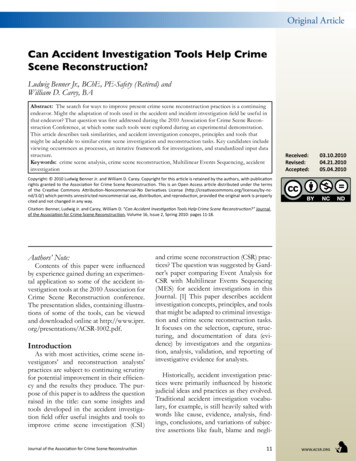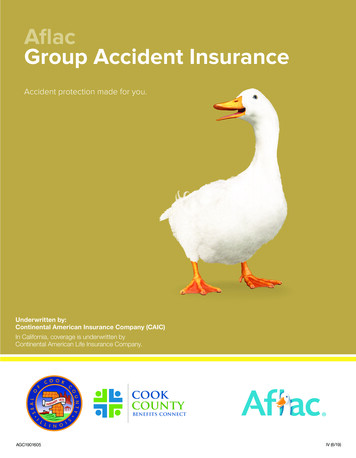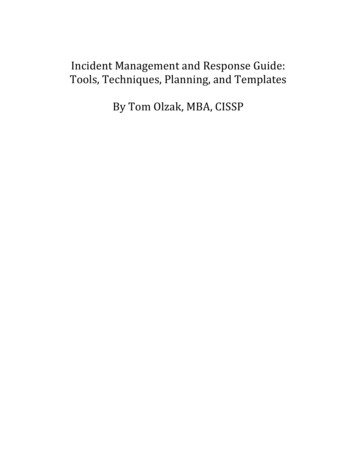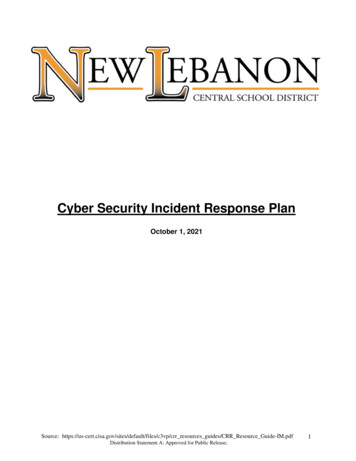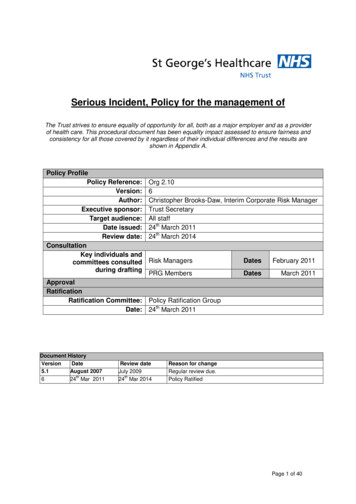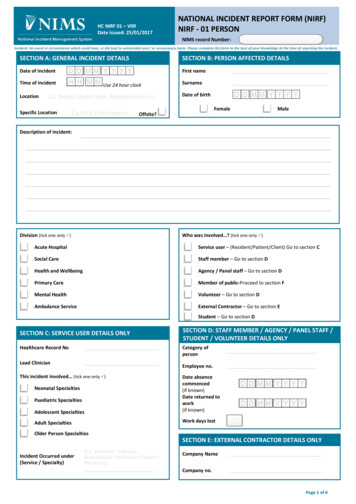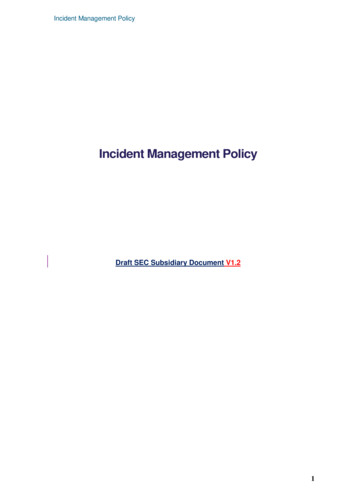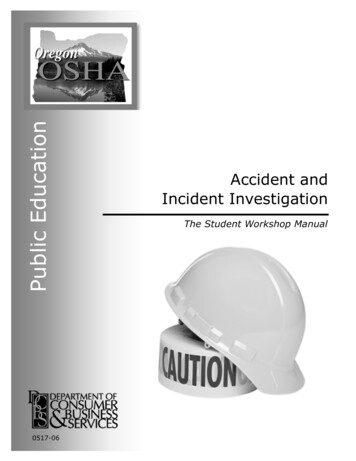
Transcription
Public Education0517-06Accident andIncident InvestigationThe Student Workshop Manual
PUBLIC EDUCATIONAccident & Incident InvestigationContact UsOregon OSHA Public Education Mission:We provide knowledge and tools to advanceself-sufficiency in workplace safety and healthConsultative Services: Offers no-cost on-site assistance to help Oregon employers recognize andcorrect safety and health problemsEnforcement: Inspects places of employment for occupational safety and health rule violationsand investigates complaints and accidentsPublic Education: Provides free training online, workshops, and training toolsStandards and Technical Resources: Develops, interprets, and provides technical advice on safety and healthstandards Creates booklets, pamphlets, and other materials to assist in the implementationof safety and health rulesField Offices:Portland: 503-229-5910Salem: 503-378-3274Eugene: 541-686-7562Medford: 541-776-6030Bend: 541-388-6066Pendleton: 541-276-2353Salem Central Office:Toll Free number in English: 800-922-2689Toll Free number in Spanish: 800-843-8086Website: www.osha.oregon.gov
PUBLIC EDUCATIONAccident & Incident InvestigationResourcesThis class is based on Oregon rules and may not be the same for all states.Consult with www.osha.gov or your state’s OSHA entity for more information.Attending an Oregon OSHA workshop or completing an online course mayprovide important information and guidance but may not meet all employertraining requirements. The following materials should not be considered asubstitute for any provisions of the Oregon Safe Employment Act or for anystandards issued by Oregon OSHA.It remains the employer’s responsibility to ensure all training requirements aremet, including any site-specific information.For more information, contact Oregon OSHA at:503-378-3272 (Main Office)800-922-2689 (English—toll free)800-843-8086 (Spanish—toll free)ed.web@oregon.govwww.orosha.orgPlease Note: This material, or any other material used to inform employers ofcompliance requirements of Oregon OSHA standards through simplification ofthe regulations should not be considered a substitute for any provisions of theOregon Safe Employment Act or for any standards issued by Oregon OSHA.
PUBLIC EDUCATIONAccident & Incident InvestigationTable of ContentsIntroduction 1The Basics 2The Six Step Process 81.Step 1 — Securing the Scene 92.Step 2 — Collecting the Facts 11Photographing the Scene 12Sketching the Scene 14Taking Video of the Scene 15Document Review 16Interviewing Techniques 173.Step 3 — Developing the Sequence of Events 234.Step 4—Determining the Cause 28Weed out the Cause of Injuries and Illness 29Steps in Cause Analysis 30Exercise: Digging up the Roots 315.Step 5 — Recommending Improvements 32Engineering and Management Controls 346.Step 6 — Writing the Report 36The Seven Elements of a Safety Program 377.Appendix — Reference Materials 38A — Average Cost for Disabling Claims 40B — Summary of Accident Investigation Rules 41C — Incident/Accident Analysis Plan 43D — Incident/Accident Team Makeup 45E — Direct Causes of Injury 48F — Sample Accident Investigators Kit 49G — Sketching Techniques 50H — Forms of Energy 51I — Accident Types and Examples 52J — Sample Accident Report Form 53K— Accident Investigation Checklist 55
PUBLIC EDUCATIONAccident & Incident InvestigationIntroductionWhat to Expect From our WorkshopThis workshop is one part of a blended learning program, which alsoincludes our online Accident Investigation course. To participate in ouronline course please visit the Oregon OSHA Public Education ent-investigation.aspxThe intent of this workshop is to help you gain the basic skills necessary to conductan effective accident investigation at your workplace. We will work through thethree primary tasks of the accident investigator, discuss employer responsibilities,and learn how to write an accident report.The three primary tasks of the accident investigator are to: Gather useful information Analyze the facts surrounding the accident Write the accident reportMost of the information about conducting an accident investigation will comedirectly from the workshop as we discuss issues, answer basic questions, andcomplete group activities. If you have prior experience in accident investigation,we hope you will participate actively so others may benefit from your valuableinput.Ultimately, we want you to leave this workshop with the skills to conduct anaccident investigation and properly complete an accident investigation report withconfidence. Experience will give you the expertise to fine-tune those skills.1
PUBLIC EDUCATIONAccident & Incident InvestigationThe BasicsThe BasicsAccident Investigation DefinitionsAccident:An unexpected incident or exposure that results in aninjury or illness to an employee or property damage.Incident:Often referred to as a near miss, this is an event that couldhave resulted in personal harm or property damage.Lost-time injury:When an employee gets injured while carrying out a worktask for the employer and unable to come in for their nextshift or a longer stretch of time.Hazard:Things or objects that have the potential to harm or causeillness.Physical Exposure:An exposure which you must come into contact with tocause an injury or illness.EnvironmentalExposure:You must be in the general area to be affected, examplesinclude: loud noises, chemicals fumes, etc.Direct cause:The result of the condition and/or behavior. The final eventwhich produces an accident.Surface cause:Hazardous conditions and unsafe employee/managementbehaviors that caused the accident.Root cause:The underlying reason the surface cause exists.Personal ProtectiveEquipment (PPE):Equipment worn to minimize exposure to a variety ofhazards. An example of PPE includes gloves or hard hats.Unsafe conditions:Unsafe equipment/tools which directly cause the accident.Unsafe actions:Harmful behaviors which contributed to the accident, thiscan include gaps in safety training for staff.Systemweaknesses:Underlying inadequate or missing programs, plans, policies,processes, and procedures that contributed to the accident.2
PUBLIC EDUCATIONAccident & Incident InvestigationThe BasicsIdentify the Proper Steps of Conducting an Accident InvestigationThe purpose of investigating accidents is todetermine the following information — The cause of the accident What changes need to be implemented If this affects other work areas and locations What policies and procedures may need to be changedWhere do workplace injuries come from? Unpreventable acts account about 2% of all workplaceaccidents Hazardous conditions account for less than 10% of allworkplace accidents Hazardous practices account for the majority (approximately 98%) of allworkplace accidentsThe unsafe practices should not be confused for blaming employees, this errorrate. Unsafe practices often come down to employee training, equipment issues,work volume, time crunches, etc.Numbers according to SAIF Loss Control Approach“Actions or conditions which are unsafe but perhaps have not beenrecognized as being unsafe or actions which have been recognized asunsafe but which are common occurrences.”“The responsibility for correction of unsafe work practicesand conditions in the workplace lies with YOU.”3
PUBLIC EDUCATIONAccident & Incident InvestigationThe BasicsWhat’s the difference between an accident and an incident?The two key conditions must exist before an accident occurs are:H and EUnpreventable acts: Only % of all workplace accidents arethought to be unpreventable. Heart attacks and other events that couldnot have been known by the employer are examples of unpreventableevents. Employers may try to place most of their injuries into this category.They justify these beliefs with such comments as: "He just lifted the boxwrong and strained his back. What could we do?" Unfortunately, theyare excuses for not looking into the "root cause" of the injury.System failure: Safety management system failures account for at least% of all workplace accidents. System failures refer toinadequate design or performance of safety programs that provide training,resources, enforcement, and supervision.No-fault accident analysisOften accident investigators confuse accident investigation with criminalinvestigation, where blame is the end result. When this occurs, it obstructs theinvestigative process because witnesses may fear punishment. A no fault analysislooks for deeper causes within the safety management system of an organization.4
PUBLIC EDUCATIONAccident & Incident InvestigationThe BasicsLaying the FoundationAccidents can be a time of confusion andhigh emotions. Having a written accidentanalysis plan which establishes what to doand when to do it can reduce decisionmaking time. Include in your plan: Who should be notified of an accident Who is authorized to notify outsideagencies (police, fire, etc.) Who is assigned to conductinvestigations (include training they willneed) Who receives and acts on investigation reports Expectation of time frames for conducting the investigation and follow-upactions such as correction of the unsafe condition or actionIt is important to secure the scene, however, before securing the sceneIf you have to wait to secure the scene due to emergency responders providingaid, begin making initial observations.Always make sure the scene is safe before you enter.It is important to act quickly and start taking pictures or video as soon as possibleas material evidence can be displaced while emergency responders tend to theinjured. Also, witnesses memories may change over time, impacted byconversations with other witnesses and the passing of time can make details fade.Finally, securing the scene also includes making the area safe until the root causecan be determined and safety controls have been implemented.5
PUBLIC EDUCATIONAccident & Incident InvestigationThe BasicsReporting to Oregon OSHA:If the accident results in a serious injury or a fatality, you are required to report itto Oregon OSHA. The reporting timelines are as follows: Fatality/serious injury*: 8 hours Catastrophe**: 8 hours All in-patient hospitalizations: 24 hours Amputations and avulsions that include bone or cartilage loss, and the loss ofan eye: 24 hours* Fatalities and some serious injuries are investigated by Oregon OSHA.When does the clock start? As soon as the employer knows one or moreof the above conditions have occurred. Do not wait to report, call 24hours a day, 7 days a week.** A catastrophe consists of 2 or more fatalities or 3 or more employeeshospitalized from the same event.To better understand the Oregon OSHA reporting rules, take our online cordkeeping-and-reporting-onlinecourse.aspxCall your OSHA Field Office to report:Portland: 503-229-5910Salem: 503-378-3274Eugene: 541-686-7562Medford: 541-776-6030Bend: 541-388-6066Pendleton: 541-276-2353Salem Central Office:Toll Free number in English: 800-922-2689Toll Free number in Spanish: 800-843-8086Web site: www.osha.oregon.gov6
PUBLIC EDUCATIONAccident & Incident InvestigationThe Six-Step ProcessThe object of every investigation is to preventit from happening again. Therefore, accidentinvestigation is not about placing blame,but about finding the factsThe Six-Step ProcessThe basic steps for conducting an accident investigation are:GatherInformationAnalyzethe FactsImplementSolutionsStep 1Securing the sceneStep 2Collecting facts about what happenedStep 3Developing the sequence of eventsStep 4Determining the causeStep 5Recommending improvementsStep 6Writing the reportThroughout this workbook we’ll look into each of these six sections more closely,breaking down the process within each step.The rules behind accident investigation can be found on Oregon OSHA’s websiteat: 0.pdf7
PUBLIC EDUCATIONAccident & Incident InvestigationStep 1—Securing the SceneStep 1 - Securing the SceneSecuring the scene is one of the most important aspects of accident investigation,it ensures others will not get injured and helps you to investigate what caused theaccident. After all injured people have been cared for, it’s time to secure thescene: Cordon off the area Turn off or block equipment Notify affected people Survey the scene for: Accident victims Involved machines, vehicles,and equipment Objects broken, damaged, orstruck Tracks or skid marks from equipment Surface defects Fluid spills/stains Contaminated materials Debris Distractions Safety devices used, not used, or failed Position of equipment Terrain (rocky, wet, slippery, frozen, cluttered, etc.) Witnesses to the accident and their locations' at the time Time of day, lighting, and weatherAlso, as you document the scene, note anythingwhich you may wish to collect and submit for sampling.8
PUBLIC EDUCATIONAccident & Incident InvestigationStep 1—Securing the SceneSecuring the SceneYour primary goal in this step is to secure theaccident scene to ensure no one else gets hurtthen to safeguard the evidence.When is it appropriate to begin the investigation?What are effective methods to secure an accident scene?Securing an accident scene is critically important, however the victim is always thefirst consideration. If you have to wait to secure the scene until medical attentionhas been provided, you can still begin noting initial observations.9
Accident & Incident InvestigationStep 2—Collecting the FactsPUBLIC EDUCATIONStep 2 - Collecting the FactsHere’s what we’ll cover:The various methods for collecting and documenting: Direct cause of injury—The result of the condition and/or behavior Hazardous conditions and unsafe employee/management behaviors (surfacecauses) that produced the accident System weaknesses (root causes) that produced the surface causes for theaccidentWe’ll also cover: Putting together your investigators kit Obtaining initial statements Reviewing documents Capturing the sceneThe investigator’s kit:Time is of the essence when an accident occurs. Don’t lose an opportunity togather important facts because you don’t have a pencil or camera at hand. Createan investigator’s kit and have it ready.Here’s what your kit may include: Camera Report forms Tape measure Paper/plastic bags with ties Clipboard, paper, pencil Sketching/Drawing Template First aid kit Warning/barricade tape Flashlight Video Equipment (optional) Personal protective equipmentappropriate to your business A duffle bag to store these itemsBe sure to test your equipment on a regular basis and make sure to have extrabatteries on hand.Your smartphone can be a handy tool to use for photos and video.10
PUBLIC EDUCATIONAccident & Incident InvestigationStep 2—Collecting the FactsDocumenting and Gathering InformationThe most effective strategy is to document as much aspossible, even if you question relevancy. It’s easy todiscard clues or leads if they prove not useful to theinvestigation.While at the scene its important to make a note of allyour observations. With clipboard in hand, take notesand try to involve all the senses. What do you see? What equipment, tools,materials, machines, structures appear to be broken, damaged, struck orotherwise involved in the accident? Look for gouges, scratches, dents, andsmears.If vehicles are involved, check for tracks and skid marks. Look for irregularities onsurfaces. Are there any fluid spills, stains, contaminated materials, or debris?What about the environment? Were there any distractions or adverse conditionscaused by weather?Photographing the sceneWorkshop attendees have commented that they oftenwish they had taken more pictures. Here are a fewthings to keep in mind as you visually document thescene: Start with distance shots, then move in closer Take photos at different angles to show the relationship of objects and details Take panoramic photos to help present the entire scene For close pictures, place an item of known dimensions in the photo to showscale, such as a ruler or dollar billTake notes for each photo. Identify the type of photo, date, time, location,subject, weather conditions, such as temperature or precipitation, measurements,and importance of the photo. Your notes should be included in the appendix ofthe report along with your photos. Finally, identify the person taking the photo.Optional: you can video the scene after providing help for injured persons11
PUBLIC EDUCATIONAccident & Incident InvestigationStep 2—Collecting the FactsSketching the SceneAccident scene sketches are crucial because theycompliment the information in photos.They are also good for indicating distances betweenthe elements of the scene.It’s important to be as precise and inclusive aspossible when making sketches. Sketchingtemplates, for example, have several commonfigures available to trace.Each sketch should include this information: Basic scene information: date, time, location, identity of objects, victims, etc. Positions: measurements that establish position of evidence, equipment, andwhere people were standing Location: where each photo was shot in relationship to the scene Indication where north is on your sketch Add the statement “not to scale”Sketch in every element of the scene, here are a few pointers. Make sketches large and clear Print legibly Indicate directions Always tie measurements to a permanent point, such as a telephone pole orbuilding Mark where people and equipment was located Include a key to explain any acronyms, symbols, or any special indicators, suchas color12
PUBLIC EDUCATIONAccident & Incident InvestigationStep 2—Collecting the FactsTaking Video at the SceneIf you have equipment or the smartphone option,begin video recording the scene as soon asemergency responders are providing care to theaccident victim, without impeding their work. Thevideo will pick up details and conversations that canadd valuable information to your investigation. Be sure to check with yoursupervisor to see what your company policy is regarding video recording.Some important points to remember when video recording the scene include: Get the lay of the land by standing back a distance and zooming into the scene Capture the entire scene 360 degrees to establish location by panning thecamera slowly in a circle Narrate what is being filmed: describe objects, size, direction, location, etc. If a vehicle was involved, record the direction of travel both coming and going Discuss with your company management about capturing the witnessdescriptions on camera, staff may need to sign a waiver Review the video when possible to note any information you may have missedSome additional video tips to keep in mind: Be careful with the zoom function; upon later review, it can be difficult to tellwhat is being captured if you’re too close Shoot from a few different angles to capture different aspects of the scene If you’re going to be recording for long stretches, consider using a tripod toreduce shaking and fatigue Transfer the digital video to your work computer for storage so it remains onfile for further review Have plenty of storage devices like memory cards, discs, or tapes on handalong with an extra battery When recording, make sure the auto focus function has been turned on toincrease the clarity of video13
PUBLIC EDUCATIONAccident & Incident InvestigationStep 2—Collecting the FactsReviewing DocumentsYou can get a lot of information from reviewingrelevant documents and records. Some documentsand records you might want to review include: Oregon OSHA form 300 and DCBS form 801 Maintenance records - to determine themaintenance history of the tools, equipment ormachinery involved in the accident and manuals Training records for the past 36 months and refresher classes - to determinethe quantity and quality of the training received by the victim and others Employee handbook and standard operating procedures (SOP) - to determinethe formally established steps in the procedures Job hazard analysis (JHA) - to determine if any hazards had been identified Safety programs and safety policies, plans, rules - such as your emergencyprogram, to determine their presence and adequacy, discipline procedures, andemergency medical plan Work schedules - to determine if the victim might have been fatigued orotherwise overworked Safety committee minutes - to determine the history of any discussion ofrelated hazardous conditions, unsafe behaviors, quarterly inspection reports,and follow up status Copies of accident investigations Personnel records of victim(s) and others involved Names of crew members and other witnesses along with the organizationalchart, and names of others who do similar work Safety inspection results along with PPE requirements for the taskWhat type of helpful information might you find in safety committeemeeting minutes:14
PUBLIC EDUCATIONAccident & Incident InvestigationStep 2—Collecting the FactsCollecting the FactsOne of the biggest challenges facing aninvestigator is to determine what is relevantto what happened, how it happened, andwhy it happened.Identifying the facts that answer thesequestions is the purpose of an effectiveinvestigation.Once the scene has been secured, it’simportant to begin collecting the facts from as many sources as possible.Be careful with preconceived notions of what happened. If you think you knowwhat happened, you may subconsciously disregard important evidence.List methods to document the accident scene and collect facts aboutwhat happened:What documents will you be interested in reviewing and why?15
PUBLIC EDUCATIONAccident & Incident InvestigationStep 2—Collecting the FactsInterviews should occur as soon as possible,once the emergency is being addressed.Initial StatementsGet initial statements from the witnesses, theseinclude a quick overview of what they saw, otherspersons that could give you more information aboutmaterials, equipment used at the time of the accident,and anything that may have been moved or disturbed while tending to theaccident victim. If time does not allow for initial statements, conduct a fullinvestigative interview.Interviewing OverviewWhen is it best to interview and why?Who should we interview and why?Where should we conduct the interview?16
PUBLIC EDUCATIONAccident & Incident InvestigationStep 2—Collecting the FactsConducting InterviewsThe purpose of the collecting facts is to gainan accurate and comprehensive picture of whathappened by capturing all pertinent facts,interpretations, and opinions. Your job, as theinterviewer, is to construct a story using the variousaccounts of the accident, and other evidence.Remember to keep the goal of the interview in mind —To determine the cause of the accidentso that similar events will not occur.Ensure that interviewees understand this as well.When conducting your interviews try to make your witnesses as comfortable aspossible. If you can, conduct your interviews in private. Try to find an office ormeeting room where you can talk comfortably and without interruptions. Keep inmind too that, for some traumatic events, the scene can provide a distraction oremotional trigger. Because investigations can lead to policy changes and/oradministrative action, don’t promise confidentiality.Approach the investigation with an open mind. If you have preconceived ideasabout the individuals or the facts, it will be obvious to the interviewees. It’simportant to let the individual you’re interviewing talk. Ask backgroundinformation first (name, job, etc.). Then ask the witness to tell you whathappened. Be friendly Ask leading questions Understanding Interrupt Ask one question at a time Put witnesses on the defensiveDo: Remain open mindedDon’t: Rush Ask open ended questions Promise confidentiality Put aside enough time Make expressions (facial, verbalof approval or disapproval)17
PUBLIC EDUCATIONAccident & Incident InvestigationStep 2—Collecting the FactsWho to Interview?Compiling a witness list is very important, some people youmay want to interview include: Witnesses: gather all of the details of what occurred;Witnesses are those that were present during any part ofthe accident The victim: determine which actions the victim took leading up to and includingthe accident Co-workers and others doing the similar work or those who work near thevictim: establish if the safety procedures for the job were being followed whenthe accident occurred, and to what the normal practices are for the task thevictim was completing Direct supervisor: understand the background information on the victim and toget procedural information about the task that was being performed Management: discuss policies and procedures specific to the victims job todetermine if all were followed, also plan to talk to the victims direct supervisorto discuss performance and any concerns or discipline Safety committee members: determine if there is a history of this safety issue Training department: gather information on the quantity and quality of trainingthe victim and others have received for the task specific to the accident Personnel department: collect information on the victim’s and others’ workhistory, discipline, and appraisals Maintenance personnel: understand the background and maintenance oninvolved equipment/machinery Police: if they responded to the scene or filed a report The victim’s spouse and family: they may have insight into the victim’s state ofmind or any issues that might be affecting them the day of the accident Other persons: anyone else with any information related to the accident18
PUBLIC EDUCATIONAccident & Incident InvestigationStep 2—Collecting the FactsInterviewing Tips and Points to Remember Prepare your questions ahead of time Introduce yourself and state the purpose of theinterview Ask clarifying questions No group interviews, conduct them one on one Listen, let the witness speak freely Do not argue, be considerate and calm Have witnesses verify the accuracy of your sketch and note their location at thetime of the accident Avoid yes or no questions by asking: who, what, where, when, why and howquestions If not recoding the interview, take notes as carefully and casually as possible Write down impressions and judgments immediately after the interview Recap and summarize main points of the interview Accidents happen fast, witnesses may only recall a few key points Arrange for a quiet room with a table and chairs to foster a relaxed atmosphere Allow yourself time to take and review notes at the end of each interview Get exact facts: time, sequence of events, and what was seen and heardSample Questions to Consider: Who has provided you the training or instruction on this process/procedure? How was the job or process different on the day of the accident? How are workers held accountable for safety? How is information about safety and health shared with you? What effort does the company take to ensure employees are held accountablefor working safely? Is there a history of prior accidents or near misses?19
PUBLIC EDUCATIONAccident & Incident InvestigationStep 2—Collecting the FactsCooperation, not intimidation, is key to a successful interview.Effective Interviewing Techniques:What should we say?Why?What should we do?Why?What should we not say?Why?What should we not do?Why?20
PUBLIC EDUCATIONAccident & Incident InvestigationStep 2—Collecting the FactsTeam Exercise: Get the FactsPurpose: Gaining as much information as possibleabout an accident is extremely important.Interviewing witnesses is both a science and an art,and can make the difference between a failed or asuccessful accident investigation. This exercise willhelp you gain a greater awareness of the interviewing techniques that will helpensure your success as an investigator. Remember, you must communicate amessage of cooperation, not intimidation.Instructions: Your instructor will describe an accident. Your team and theinstructor are located at the scene of the accident and your job now is to askfollow-up questions to gather information about the accident. Use the space belowfor your notes:21
PUBLIC EDUCATIONAccident & Incident InvestigationStep 3—Developing the Sequence of EventsStep 3 - Developing the Sequence of EventsThe next two steps help you organize and analyze the information gatheredso that you may accurately determine the surface and root cause(s).An accident is the final event in an unplanned processIn this step, we take the information gathered in step 2, Collecting the Facts, todetermine the events prior to, during, and after the accident. Once the sequenceof events have been developed, you can then study each factor/action todetermine unsafe conditions (things or circumstances which directly caused theaccident) and unsafe actions. Actions taken or not taken that contributed to the event System weaknesses, such as underlying inadequate or missing programs Plans, policies, processes, and procedures that contributed to the accidentWhen we understand that an accident isactually the final event in an unplannedprocess, we’ll naturally want to knowwhat the preceding events/factors were.The key is to take the informationgathered and arrange it so that we canaccurately determine what initial conditionsand/or actions turned the planned workprocess into an
Solutions Step 6 Writing the report The object of every investigation is to prevent it from happening again. Therefore, accident investigation is not about placing blame, but about finding the facts Throughout this workbook we'll look into each of these six sections more closely, breaking down the process within each step.

